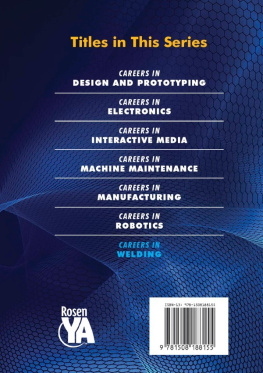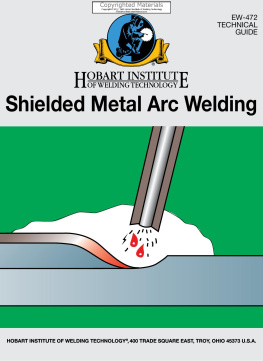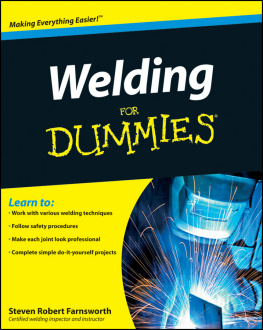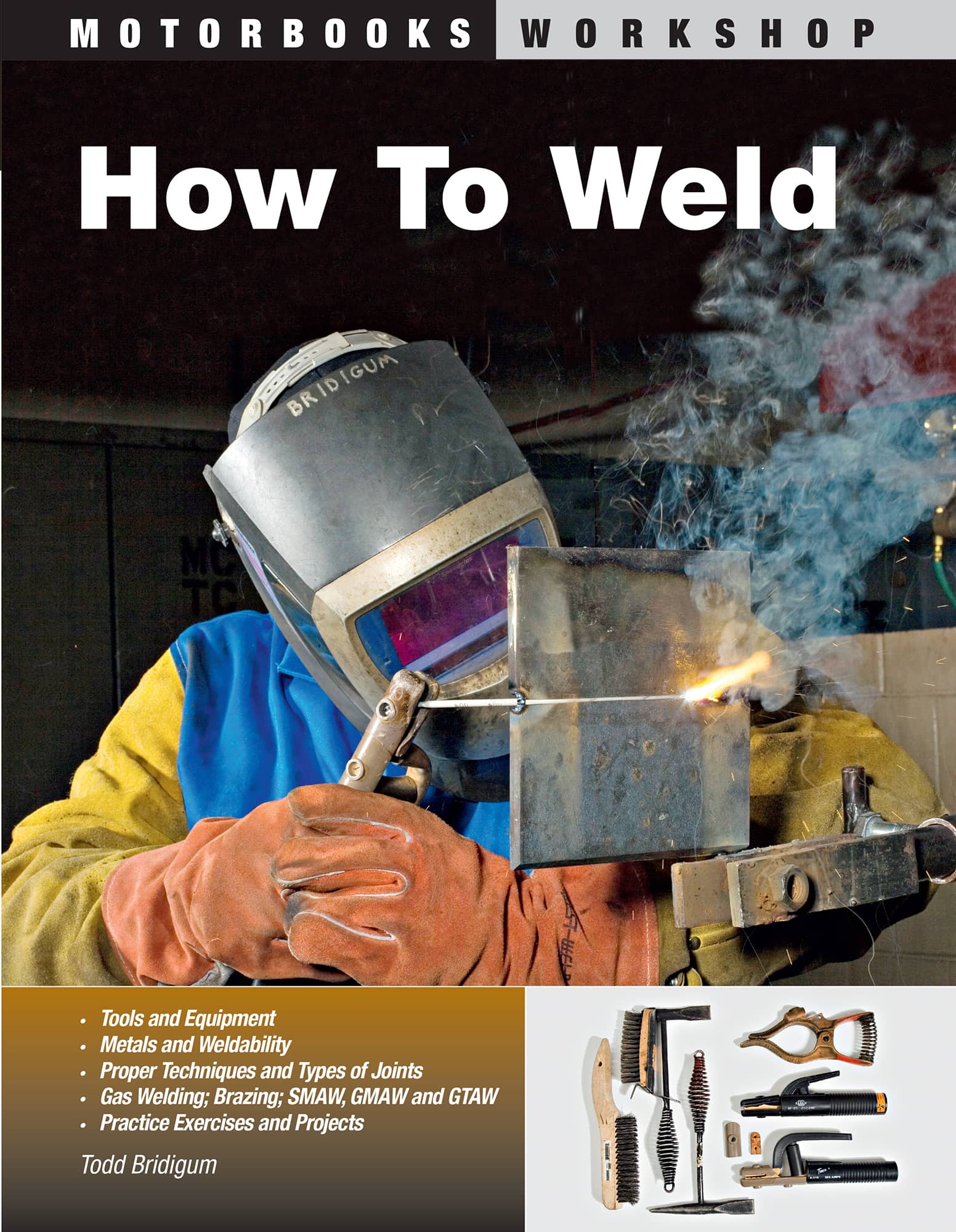M any books have been written about welding, so when I took up the challenge to write one, I wanted to set it apart from the others. Some of the published books have a lot of technical content, but are difficult for the nonprofessional to read. Others specialize in one or two welding processes, are outdated, or fall short in explaining how to weld. As a welding instructor Ive taught hundreds of students how to weld with varying degrees of success. In my experience some people have a natural talent for it; for others it is more difficult to learn. Only a few just didnt get it or were too afraid of fire, but I could count them on one hand.
The next question is, can you learn how to weld from a book or do you need an instructors help? The role I play in the classroom is that of diagnostician. In other words, after someone knows how to operate the equipment safely and has done some basic exercises then it is a matter of figuring out what they are doing wrong and making a correction.
Troubleshooting is the key to good welding. Sometimes it is something wrong with the equipment and/or materials being used, which I always look at first and is easy to fix. If it is not the materials or equipment then it is operator errorsomething is wrong with the students welding technique. This is a far more difficult problem to correct because it has to do with an individuals hand/eye coordination, body position, perception of distances and angles, and old habits. Without an instructor telling you what to change, it is more difficult to learn how to weld, but not impossible.
In this book I strive to provide useful information for you to work safely and troubleshoot your own problems, yet I would strongly advise taking a class to get more welding time and access to a variety of welding and fabrication equipment. Bear in mind that not all instructors are created equal. If you can get recommendations from former welding students or people who work at your local welding supplier, you may find an instructor who can help you a great deal.
AWS A3.0:2001, Figure 54a, Reproduced with permission from the American Welding Society (AWS), Miami, FL USA

CHAPTER 1
HISTORY AND PROCESS OVERVIEW
H ere is a fun way to think about how important welding and metal fabrication are to our standard of living today. What if all the welds in the world came apart at one time and welders werent available to repair them? Society as we know it would fall apart, or at least electricity would go away. Power plants are held together by welds and maintained by pipefitters, ironworkers, boilermakers, and machinists. All of us rely on electricity and on those skilled professionals for our standard of living. What about wind and solar panels? Each of these relies on manufacturing processes and welding to be fabricated and installed.
I believe metal fabrication is the single largest influence on how the world looks today, from the cities to the country and even into space. Today we tend to think in the short term, which is understandable since our computers, cell phones, cars, and televisions seem to be outdated or obsolete every few years. If we back up and look at the larger picture in the context of welding, the technology available to work and join metals is extraordinary.
Humankind moved from the Stone Age into the Bronze Age about 5,500 years ago. Copper was the first metal to be worked because it exists in its pure form in nature, and using it didnt require separating iron from ore. About 3,200 years ago, people discovered how to separate iron from rock and the Iron Age began. Forge welding, the first metal-joining process, was developed during the Iron Age. The people able to transform rock into usable iron tools through forge welding, known to us today as blacksmiths, were thought to possess magical powers a few millennia ago. It took a lot of time, work, and skill to fabricate metal, and for thousands of years that is all we had.
Then, in the late 1800s and early 1900s, gas, arc, and resistance welding were discovered. These breakthroughs, combined with Bessemers furnace (which enabled industry to make large quantities of highquality steel) led the world through the last stages of the Industrial Revolution and into the modern age. Yet if we look at the Brooklyn Bridge and Eiffel Tower, both were constructed during the 1880s and both are riveted together, not welded. In those days, welding processes produced hard, brittle welds that were not suitable for joining large sections of iron or steel under heavy loads. The development of a flux coating on the welding rod was the key to making arc welding more usable, but that took another 50 years to perfect. By the 1930s, welding was being used to construct ships, pipelines, and skyscrapers. For better or worse, war has been the main factor in the advancement of many technologies, including metalworking. The biggest warsWorld Wars I and II and the Cold Warprecipitated the biggest advances in welding. Research and development of new technologies has trickled down to civilian use.
Modern equipment allows us to easily do welding jobs at home that would take a blacksmith weeks to complete. You can find highquality steel, aluminum, and other metals in almost any structural shape and size at the local steel yard. Joining them is as easy as pulling the trigger of a wirefeed gun.
Still, welding is a skill difficult to master. Think of it like this: I can put a bandaid on someones cut and give them an aspirin, but that doesnt make me a doctor. I can change a light fixture and its switch in my home, but that doesnt make me an electrician. Just because someone can lay a bead does not make him or her a welder.
The good news is we no longer have to dedicate our lives to the craft in order to join metals. But we should recognize the difference between what we know how to do and a professional who has spent most of his life learning and working in the trade. New ways of processing, refining, and combining metals, as well as the further development of new welding processes using lasers, electron beams, and friction, indicate that the rate of new discoveries and applications of different metaljoining processes will continue into the foreseeable future. The Internet and books are great resources to learn more about the history of welding and metalworking.
WELDING PROCESSES OVERVIEW
Welding processes can be divided into two basic categories: manual and automated. This book deals with the former, the manual processes, the ones in which the person doing the work has a direct influence on how the weld turns out. This puts the pressure on the person operating the equipment to produce a good weld.
Some of the manual processes are considered semiautomatic, in which one or several aspects of the weld is controlled by the machine. For example, in wirefeed welding the wire is automatically electrified and fed into the molten puddle by the machine. Two processes, which can be manually operated but are more commonly automated, are not covered in this book: plasma arc welding (PAW) and submerged arc welding (SAW). Both have applications in industry, but are not common in most metal fabrication shops because of lack of need or cost of equipment.











